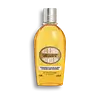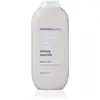What's inside
What's inside
 Key Ingredients
Key Ingredients

No key ingredients
 Benefits
Benefits

 Concerns
Concerns

 Ingredients Side-by-side
Ingredients Side-by-side

Vitis Vinifera Seed Oil
EmollientTipa-Laureth Sulfate
CleansingLaureth-3
EmulsifyingCaprylic/Capric Triglyceride
MaskingParfum
MaskingCocamide Mea
EmulsifyingPropylene Glycol
HumectantSorbitan Oleate
EmulsifyingPrunus Amygdalus Dulcis Oil
Skin ConditioningCitrus Aurantium Bergamia Fruit Oil
MaskingHelianthus Annuus Seed Oil
EmollientRosmarinus Officinalis Leaf Extract
AntimicrobialTocopherol
AntioxidantWater
Skin ConditioningLimonene
PerfumingCoumarin
PerfumingLinalool
PerfumingVitis Vinifera Seed Oil, Tipa-Laureth Sulfate, Laureth-3, Caprylic/Capric Triglyceride, Parfum, Cocamide Mea, Propylene Glycol, Sorbitan Oleate, Prunus Amygdalus Dulcis Oil, Citrus Aurantium Bergamia Fruit Oil, Helianthus Annuus Seed Oil, Rosmarinus Officinalis Leaf Extract, Tocopherol, Water, Limonene, Coumarin, Linalool
Water
Skin ConditioningSodium Lauryl Sulfate
CleansingCocamidopropyl Betaine
CleansingParfum
MaskingCoumarin
PerfumingHexyl Cinnamal
PerfumingLinalool
PerfumingPolyglyceryl-3 Laurate
EmulsifyingGlycol Distearate
EmollientMethyl Glucose Caprate/Caprylate/Oleate
EmollientPropanediol
SolventAmmonium Chloride
BufferingCoco-Glucoside
CleansingDecyl Glucoside
CleansingC10-18 Triglycerides
EmollientLauryl Lactate
EmollientOryza Sativa Bran Extract
Skin ConditioningCocos Nucifera Oil
MaskingButyrospermum Parkii Butter Extract
Skin ConditioningGlycerin
HumectantTetrasodium EDTA
Glyceryl Oleate
EmollientGlycol Stearate
EmollientCitric Acid
BufferingEthylhexylglycerin
Skin ConditioningSodium Benzoate
MaskingSodium Hydroxide
BufferingPotassium Sorbate
PreservativePhenoxyethanol
PreservativeMethylchloroisothiazolinone
PreservativeMethylisothiazolinone
PreservativeWater, Sodium Lauryl Sulfate, Cocamidopropyl Betaine, Parfum, Coumarin, Hexyl Cinnamal, Linalool, Polyglyceryl-3 Laurate, Glycol Distearate, Methyl Glucose Caprate/Caprylate/Oleate, Propanediol, Ammonium Chloride, Coco-Glucoside, Decyl Glucoside, C10-18 Triglycerides, Lauryl Lactate, Oryza Sativa Bran Extract, Cocos Nucifera Oil, Butyrospermum Parkii Butter Extract, Glycerin, Tetrasodium EDTA, Glyceryl Oleate, Glycol Stearate, Citric Acid, Ethylhexylglycerin, Sodium Benzoate, Sodium Hydroxide, Potassium Sorbate, Phenoxyethanol, Methylchloroisothiazolinone, Methylisothiazolinone
 Reviews
Reviews

Ingredients Explained
These ingredients are found in both products.
Ingredients higher up in an ingredient list are typically present in a larger amount.
Coumarins are a group of substances found naturally in plants. There are over 1300 types of coumarins identified. It has a natural vanilla scent.
Coumarin is an identified EU known allergy, meaning it may cause an allergic reaction when applied to the skin.
In many countries, coumarin is banned as a food additive. However, it can be found in soaps, tobacco products, and some alcohol drinks.
Plants use coumarins as a chemical defense. Some plants that have coumarins include lavender, tonka beans, and yellow clovers.
Learn more about CoumarinLinalool is a fragrance and helps add scent to products. It's derived from common plants such as cinnamon, mint, citrus, and lavender.
Like Limonene, this ingredient oxidizes when exposed to air. Oxidized linalool can cause allergies and skin sensitivity.
This ingredient has a scent that is floral, spicy tropical, and citrus-like.
Learn more about LinaloolParfum is a catch-all term for an ingredient or more that is used to give a scent to products.
Also called "fragrance", this ingredient can be a blend of hundreds of chemicals or plant oils. This means every product with "fragrance" or "parfum" in the ingredients list is a different mixture.
For instance, Habanolide is a proprietary trade name for a specific aroma chemical. When used as a fragrance ingredient in cosmetics, most aroma chemicals fall under the broad labeling category of “FRAGRANCE” or “PARFUM” according to EU and US regulations.
The term 'parfum' or 'fragrance' is not regulated in many countries. In many cases, it is up to the brand to define this term.
For instance, many brands choose to label themselves as "fragrance-free" because they are not using synthetic fragrances. However, their products may still contain ingredients such as essential oils that are considered a fragrance by INCI standards.
One example is Calendula flower extract. Calendula is an essential oil that still imparts a scent or 'fragrance'.
Depending on the blend, the ingredients in the mixture can cause allergies and sensitivities on the skin. Some ingredients that are known EU allergens include linalool and citronellol.
Parfum can also be used to mask or cover an unpleasant scent.
The bottom line is: not all fragrances/parfum/ingredients are created equally. If you are worried about fragrances, we recommend taking a closer look at an ingredient. And of course, we always recommend speaking with a professional.
Learn more about ParfumWater. It's the most common cosmetic ingredient of all. You'll usually see it at the top of ingredient lists, meaning that it makes up the largest part of the product.
So why is it so popular? Water most often acts as a solvent - this means that it helps dissolve other ingredients into the formulation.
You'll also recognize water as that liquid we all need to stay alive. If you see this, drink a glass of water. Stay hydrated!
Learn more about Water